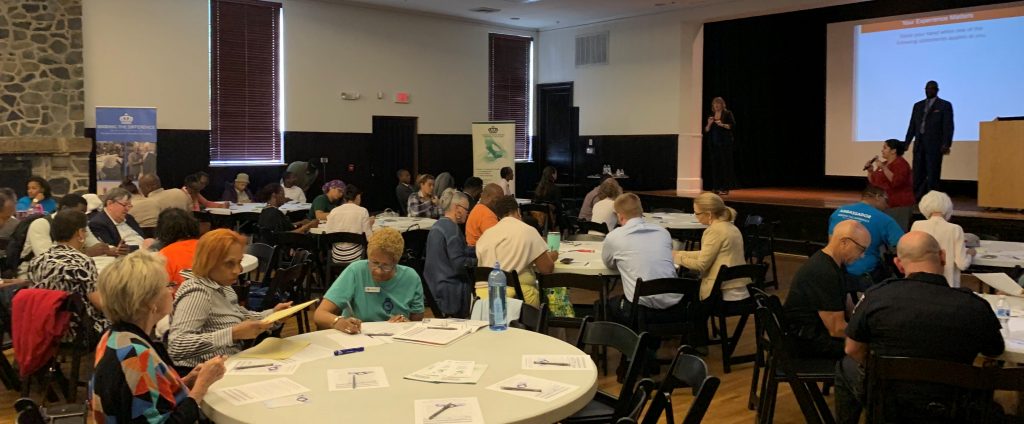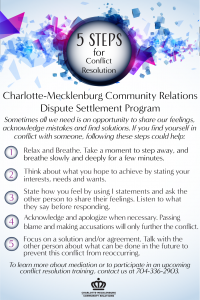
In a fast-growing city like Charlotte (N.C.), many factors can contribute to rising crime rates. There is, however, a common driver that has been identified… individuals who know each other settling disputes with gunfire. The Charlotte-Mecklenburg Police Department (CMPD) has numerous crime reduction strategies in place including their launch of a Crisis Intervention Team and Community Policing Crisis Response Team but they also value partnerships across the community that join them in efforts to help keep the city safe. Charlotte-Mecklenburg Community Relations is a very strong partner in this work and offers comprehensive conflict resolution training to the community. Putting an emphasis on teaching people how to resolve conflict without violence could have a significant impact on issues Charlotte is experiencing. It is critical that conflict resolution be offered to both youth and adults which is why Community Relations has also partnered with schools to offer peer mediation programs.
The community was recently invited to participate in a community conversation so that collectively, everyone could work together to address crime in Charlotte. The goal was to provide attendees with an overview of conflict resolution training and allow them to have impactful dialogue about what can be done to break the cycle of violence. Following a brief overview of current statistics, attendees were asked to raise their hands when certain statements about violence and conflict applied to them. The majority of people in the room raised their hand when the first statement was read: “You or someone you know have been personally impacted by violence.” This was a powerful exercise reinforcing that everyone should have a vested interest in public safety. Part of understanding how to deal with conflict is identifying your own conflict resolution style. Attendees were given a worksheet to complete that would help them assess how they deal with conflict. Their calculated scores revealed their conflict resolution style: collaborating, competing, avoiding, accommodating or compromising. This activity helped get the conversation going and allowed attendees to apply a more personal lens to what they were about to learn. Each style was defined and scenarios showed how outcomes can change when styles are exhibited in difficult situations. The style assessment, active listening, causes of conflict and more are all part of the two-day training that Community Relations offers. It was evident that many of the attendees were interested in taking a deeper dive into conflict resolutions and ways that they can help others in the community.
It was then time for table discussions where attendees would have an opportunity to connect with one another, listen and share different perspectives on what was taking place in Charlotte. They spent nearly an hour having these powerful conversations based on four questions. Highlighted below are consistent themes mentioned during the table report-out.

1. What do you believe is the biggest contributor to the rise in crime throughout our community?
Growth, economy, racial disparity, access to guns, mindset and interpersonal conflict.
2. What are some ways that we can work together to address violence in Charlotte?
Collaboration over competition, accountability, community trust, youth involvement, commitment and cultural awareness.
3. What resources does the community need for this work to be successful?
Mentoring programs, engagement, recreation centers/shared spaces, and creative outlets.
4. What are you personally willing to do to help break the cycle of violence?
Commit time, support programs, teach conflict resolution, be a community advocate, role model, volunteer and actively engage.
A diverse group of people were brought together to address a community concern and ended up feeling hopeful and empowered. Not only did the attendees want to keep the dialogue going but many exchanged contact information so that they could continue to work together. Many attendees expressed the desire to attend more of these types of conversations, participate in the full two-day training and invite people in their networks to be a part of the solution.
Since the event, there been multiple requests for conflict resolution training for specific groups and organizations. Community Relations plans to expand their conflict resolution service offerings and continue partnering with CMPD to train community ambassadors through their Bridge the Difference initiative. For more information on Community Relations’ conflict resolution training, contact infocrc@charlottenc.gov. For information on CMPD’s Bridge the Difference engagement initiative, visit: https://bridgethedifferencenc.com/
Questions for readers:
1. What engagement methods are you using to address issues in your community?
2. How are you empowering residents to be part of the solution?
3. What tools are you providing the community that will equip them to help others?
Traci, I really appreciate you sharing this story. What a great example of local government thinking of engagement in terms of partnering and empowering. It emphasizes community as in WE, you and I, as opposed to US and THEM. I think when local government officials think of engagement in terms of we, like CMPD has done here, it reinforces the idea that it is not “we the community and them the CMPD,” but rather, “we the community,” inclusive of residents and the agencies there to serve them. That is why questions #2 and #4 are particularly powerful. Rather than just asking for “input” (what do you need us to do for you), it is saying, “what can we do, together.” Terrific. I’d love to hear, over time, stories that come out of this effort.
Thanks for the comment Rick. I am glad that you liked the post! You are spot on in us making sure we convey that everyone must work to make our community better. I will definitely write a follow-up piece to this in the coming months to share progress and stories.